What Is Soil?
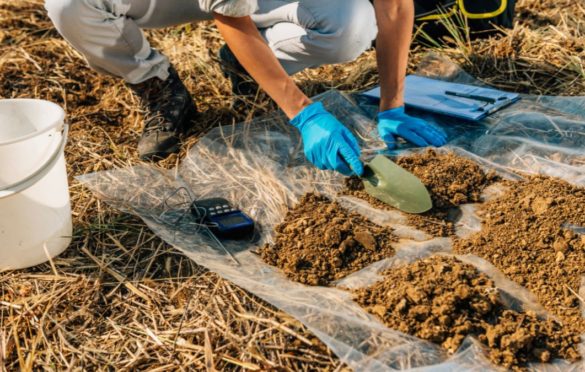
Soil is a combination of mineral and organic matter, water, and air—the portion of the regolith that supports the growth of plants.
Weathering is a key process in the formation of soil. Along with air and water, soil is one of our most indispensable resources. Also like air and water, soil is often taken for granted. The following quote helps put this vital layer in perspective:
Science, in recent years, has focused more and more on the Earth as a planet, one that for all we know is unique—where a thin blanket of air, a thinner film of water, and the thinnest veneer of soil combine to support a web of life of wondrous diversity in continuous change.
Soil has accurately been called “the bridge between life and the inanimate world.” All life—the entire biosphere—owes its existence to a dozen or so elements that must ultimately come from Earth’s crust. Once weathering and other processes create soil, plants carry out the intermediary role of assimilating the necessary elements and making them available to animals, including humans.
An Interface in the Earth System
Soil is considered an interface—a common boundary where different parts of a system interact.
This is an appropriate designation because soil forms where the geosphere, the atmosphere, the hydrosphere, and the biosphere meet. Soil is a material that develops in response to complex environmental interactions among different parts of the Earth system. Over time, soil gradually evolves to a state of equilibrium, or balance, with the environment. Soil is dynamic and sensitive to almost every aspect of its surroundings. Thus, when environmental changes occur, such as changes in climate, vegetative cover, and animal (including human) activity, the soil responds. Any such change gradually alters soil characteristics until a new balance is reached.
Although thinly distributed over the land surface, soil functions as a fundamental interface, providing an excellent example of the integration among many parts of the Earth system.
What Is Soil?
With few exceptions, Earth’s land surface is covered by regolith, a layer of rock and mineral fragments produced by weathering. Some would call this material soil, but soil is more than an accumulation of weathered debris. Soil is a combination of mineral and organic matter, water, and air—the portion of the regolith that supports the growth of plants. Although the proportions of the major components in soil vary, the same four components are always present to some extent.
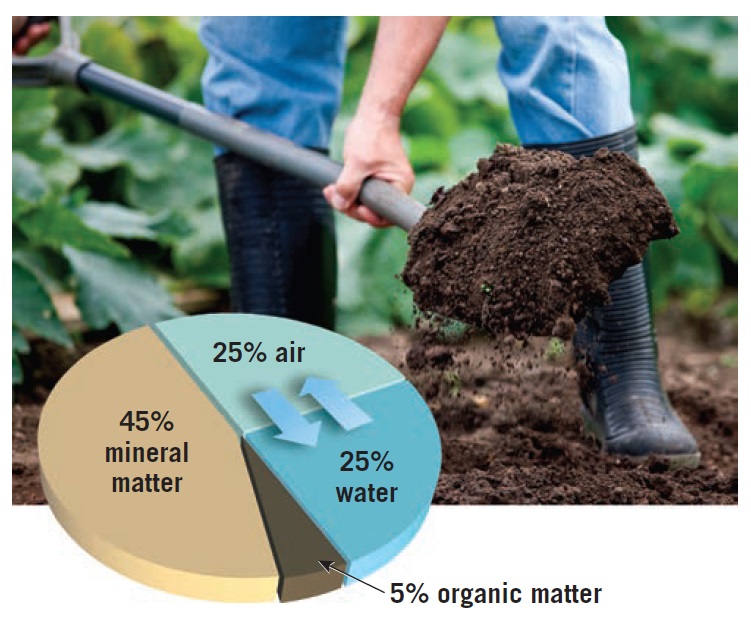
About onehalf of the total volume of good-quality surface soil is a mixture of disintegrated and decomposed rock (mineral matter) and humus, the decayed remains of animal and plant life (organic matter). The remaining half consists of pore spaces among the solid particles where air and water circulate.
Soil Texture and Structure
Most soils are far from uniform and contain particles of different sizes. Soil texture refers to the proportions of different particle sizes. Texture is a basic soil property because it strongly influences the soil’s ability to retain and transmit water and air, both of which are essential to plant growth. Sandy soils may drain too rapidly and dry out quickly. At the opposite extreme, the pore spaces of clay-rich soils may be so small that they inhibit drainage, and long-lasting puddles result. Moreover, when the clay and silt content is very high, plant roots may have difficulty penetrating the soil.
Because soils rarely consist of particles of only one size, textural categories have been established based on the varying proportions of clay, silt, and sand. The standard system of classes used by the U.S. Department of Agriculture is shown in Figure.
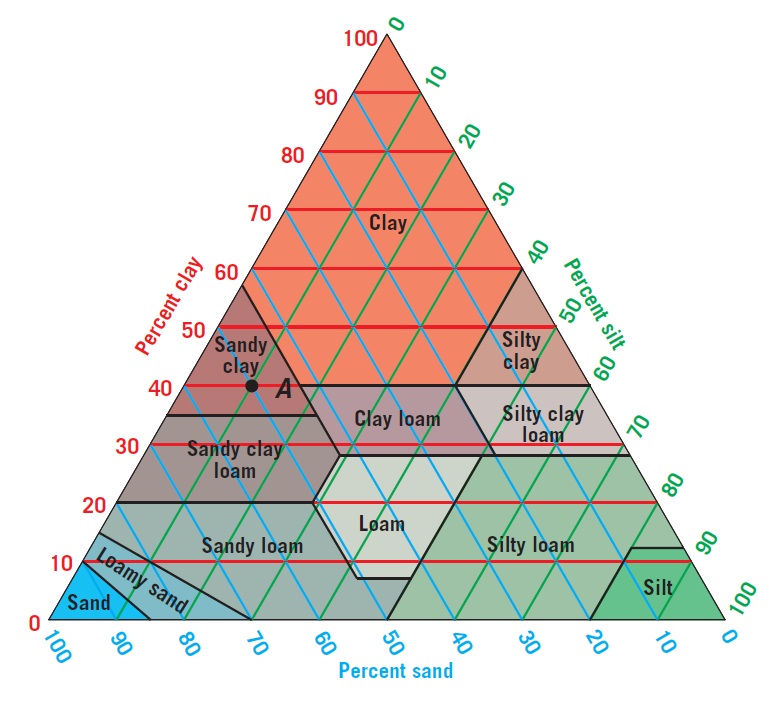
For example, point A on this triangular diagram (left center) represents a soil composed of 10 percent silt, 40 percent clay, and 50 percent sand. Such a soil is called a sandy clay. The soils called loam, which occupy the central portion of the diagram, are those in which no single particle size predominates over the other two. Loam soils are best suited to support plant life because they generally hold moisture and nutrients better than do soils composed predominantly of clay or coarse sand.
Soil particles are seldom completely independent of one another. Rather, they usually form clumps called peds that give soils a particular structure. Four basic soil structures are recognized: platy, prismatic, blocky, and spheroidal. Soil structure is important because it influences how easily a soil can be cultivated as well as how susceptible a soil is to erosion. Soil structure also affects a soil’s porosity and permeability (the ease with which water can penetrate). This in turn influences the movement of nutrients to plant roots. Prismatic and blocky peds usually allow for moderate water infiltration, whereas platy and spheroidal structures are characterized by slower infiltration rates.
Describing and Classifying Soil
The factors controlling soil formation vary greatly from place to place and from time to time, leading to an amazing variety of soil types.
The Soil Profile
Because soil-forming processes operate from the surface downward, soil composition, texture, structure, and color gradually evolve differently at varying depths.
These vertical differences, which usually become more pronounced as time passes, divide the soil into zones or layers known as horizons. If you were to dig a pit in soil, you would see that its walls are layered. Such a vertical section through all of the soil horizons constitutes the soil profile.
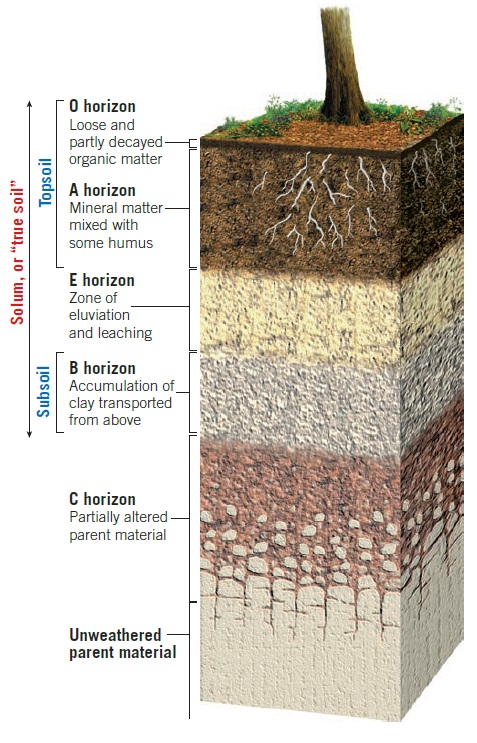
Figure presents an idealized view of a welldeveloped soil profile in which five horizons are identified. From the surface downward, they are designated as O, A, E, B, and C. These five horizons are common to soils in temperate regions; not all soils have these five layers. The characteristics and extent of horizon development vary in different environments. Thus, different localities exhibit soil profiles that can contrast greatly with one another:
-The O soil horizon consists largely of organic material, in contrast to the layers beneath it, which consist mainly of mineral matter. The upper portion of the O horizon is primarily plant litter, such as loose leaves and other organic debris that are still recognizable. By contrast, the lower portion of the
O horizon is made up of partly decomposed organic matter (humus) in which plant structures can no longer be identified. In addition to plants, the O horizon is teeming with microscopic life, including bacteria, fungi, algae, and insects. All these organisms contribute oxygen, carbon dioxide, and organic acids to the developing soil.
-The A horizon is largely mineral matter, yet biological activity is high, and humus is generally present— up to 30 percent in some instances. Together the O and A horizons make up what is commonly called the topsoil.
– The E horizon is a light-colored layer that contains little organic material. As water percolates downward through this zone, finer particles are carried away. This washing out of fine soil components is termed eluviation. Water percolating downward also dissolves soluble inorganic soil components and carries them to deeper zones. This depletion of soluble materials from the upper soil is termed leaching.
-The B horizon, or subsoil, is where much of the material removed from the E horizon by eluviation is deposited. Thus, the B horizon is often referred to as the zone of accumulation. The accumulation of the fine clay particles enhances this horizon’s ability to hold water. In extreme cases, clay accumulation can form a very compact, impermeable layer called hardpan.
-The O, A, E, and B horizons together constitute the solum, or “true soil.” It is in the solum that soilforming processes are active and that living roots and other plant and animal life are largely confined.
-The C horizon is characterized by partially altered parent material. Whereas the parent material is difficult to see in the O, A, E, and B horizons, it is easily identifiable in the C horizon. Although this material is undergoing changes that will eventually transform it into soil, it has not yet crossed the threshold that separates regolith from soil.
The characteristics and extent of development can vary greatly among soils in different environments. The boundaries between soil horizons may be sharp, or the horizons may blend gradually from one to another.
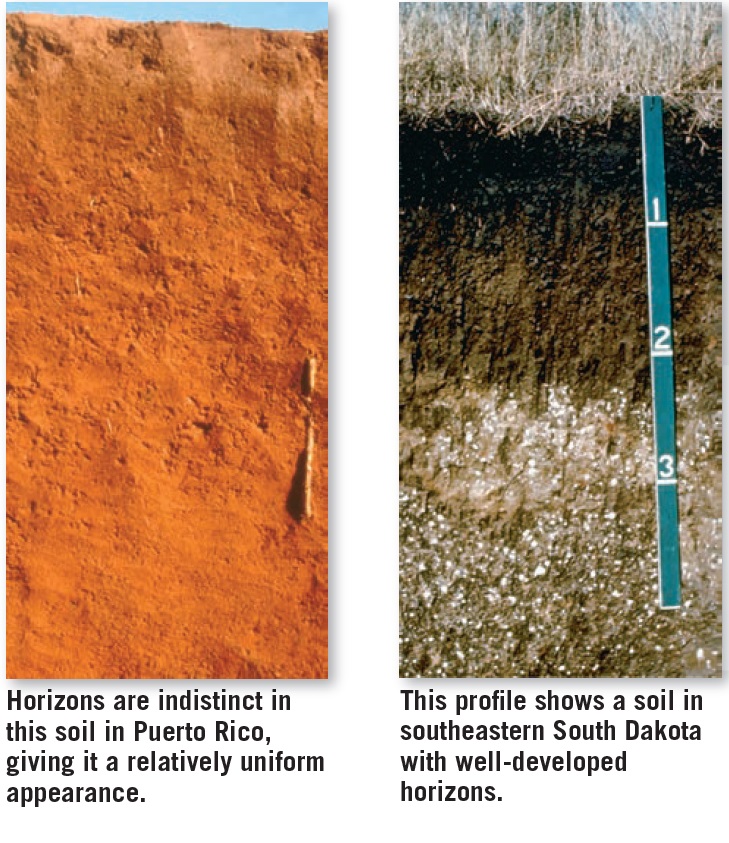
Consequently, a well-developed soil profile indicates that environmental conditions have been relatively stable over an extended time span and that the soil is mature. By contrast, some soils lack horizons altogether. Such soils are called immature because soil building has been going on for only a short time. Immature soils are also characteristic of steep slopes, where erosion continually strips away the soil, preventing full development.
Classifying Soils
The great variety of soils on Earth makes it essential to devise some means of classifying the vast array of soil data. Establishing categories of items having certain important characteristics in common introduces order and simplicity, which not only aids comprehension and understanding but also facilitates analysis and explanation.
Soil scientists in the United States have devised a system for classifying soils known as the Soil Taxonomy. It emphasizes the physical and chemical properties of the soil profile and is organized on the basis of observable soil characteristics. There are 6 hierarchical categories of classification, ranging from order, the broadest category, to series, the most specific category. The system recognizes 12 soil orders and more than 19,000 soil series. The names of the classification units are mostly combinations of Latin or Greek descriptive terms. For example, soils of the order aridosol (from the Latin aridus 5 dry and solum 5 soil) are characteristically dry soils in arid regions. Soils in the order inceptisol (from Latin inceptum 5 beginning and solum 5 soil) are soils with only the beginning, or inception, of profile development.
Basic Soil Orders
| Soil Order | Description | Percentage* |
| Alfisol | Moderately weathered soils formed under boreal forests or broadleaf deciduous forests, rich in iron and aluminum. Clay particles accumulate in a subsurface layer due to leaching in moist environments. Fertile, productive soils because they are neither too wet nor too dry. |
9.65 |
| Andisol | Young soils in which the parent material is volcanic ash and cinders, deposited by recent volcanic activity. | 0.7 |
| Aridosol | Soils that develop in dry places with insufficient water to remove soluble minerals; may have calcium carbonate, gypsum, or salt accumulation in subsoil; low organic content. | 12.02 |
| Entisol | Young soils with limited development and exhibiting properties of the parent material. Productivity ranges from very high for some forming on recent river deposits to very low for those forming on shifting sand or rocky slopes. | 16.16 |
| Gelisol | Young soils with little profile development, found in regions with permafrost. Low temperatures and frozen conditions for much of the year; slow soil-forming processes. | 8.61 |
| Histosol | Organic soils found in any climate where organic debris accumulates to form a bog soil. Dark, partially decomposed organic material commonly referred to as peat. | 1.17 |
| Inceptisol | Weakly developed young soils showing the beginning (inception) of profile development. Most common in humid climates but found from the arctic to the tropics. Native vegetation is most often forest. | 9.81 |
| Mollisol | Dark, soft soils developed under grass vegetation, generally found in prairie areas. Humus-rich surface horizon that is rich in calcium and magnesium; excellent fertility. Also found in hardwood forests with significant earthworm activity. Climatic range is boreal or alpine to tropical. Dry seasons are normal. | 6.89 |
| Oxisol | Soils formed on old land surfaces unless parent materials were strongly weathered before they were deposited. Generally found in the tropics and subtropical regions. Rich in iron and aluminum oxides, oxisols are heavily leached and hence are poor soils for cultivation. | 7.5 |
| Spodosol | Soils found only in humid regions on sandy material. Common in northern coniferous forests and cool humid forests. Beneath the dark upper horizon of weathered organic material lies a light colored leached horizon, the distinctive property of this soil. | 2.56 |
| Ultisol | Soils representing the products of long periods of weathering. Percolating water concentrates clay particles in the lower horizons. Restricted to humid climates in the temperate regions and the tropics, where the growing season is long. Abundant water and a long frost-free period contribute to extensive leaching and poor fertility. | 8.45 |
| Vertisol | Soils containing large amounts of clay, which shrink when dry and swell with the addition of water. Found in subhumid to arid climates if sufficient water is available to saturate the soil after periods of drought. Soil expansion and contraction exert stresses on human structures. | 2.24 |
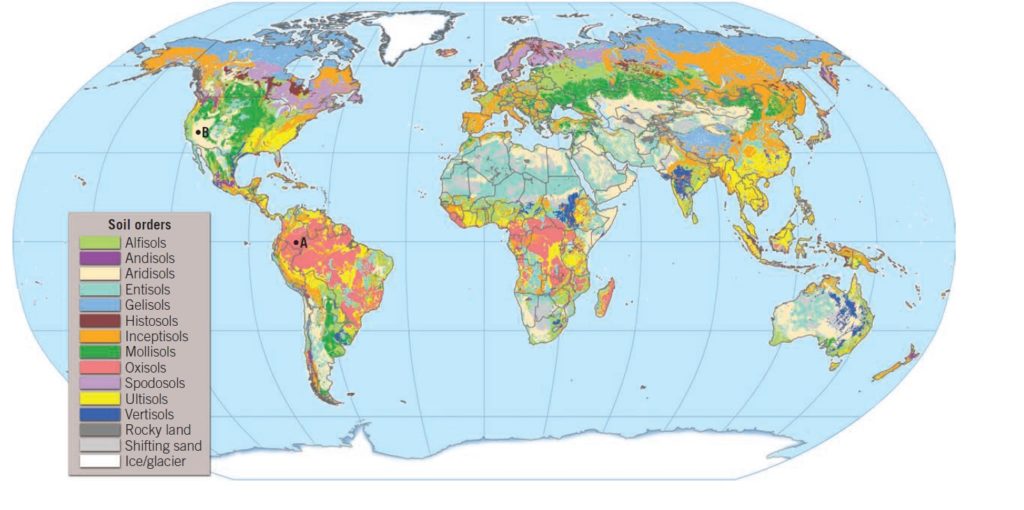
Brief descriptions of the 12 basic soil orders are provided in Table and Figure “Global soil regions” shows the complex worldwide distribution pattern of the Soil Taxonomy’s 12 soil orders. Like many other classification systems, the Soil Taxonomy is not suitable for every purpose.
It is especially useful for agricultural and related land-use purposes, but it is not a useful system for engineers who are preparing evaluations of potential construction sites.
Get the book about geotechnical engineering soil and foundation principles and practice:
Enter your email to have the book sent to you.
